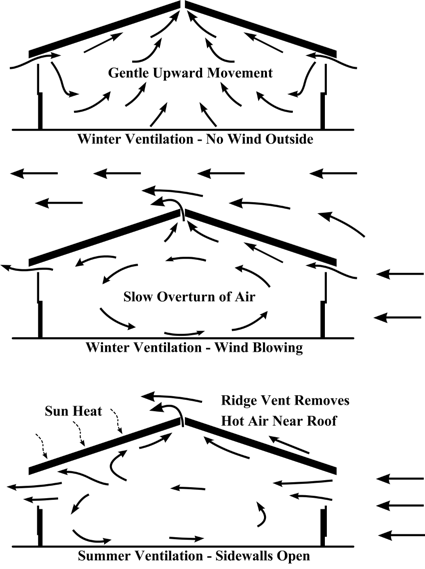The plan is 10x14. It will be board and batten pine siding and doors, plywood floor, 4:12 shingled roof on plywood with almost 12" eaves, 2 single pane "barn windows" that open inward from the bottom (hinges at the top of each window) and hook open more than 90 degrees up. It has double doors 3'x7' each on the west end and a single 4'x7' door on the south side near the east end. The 4 or 5 hens will get the east 6 or 7 feet of the building; garden tools and chicken supplies get the west end. Woven wire with a 2" x 4" mesh to divide the chickens from the rest of the building. That makes 10 to a little over 15 square feet per hen. They will go out some but not reliably enough to count that for space per bird. I will be able to bring some entertainment in to them regularly, although that will be a lot easier vary in the summer. Is that enough space for most breeds or should I make sure to pick breeds that are more likely to tolerate confinement?
I'm upper midwest so it gets cold and can get very snowy. Zone 5b (or so). Lowest it normally gets is ten below or so (F.), it doesn't stay there longer than a few days. Weeks straight of teens and mid twenties is common, though. Highs in the summer hit 90's and stayed there for several weeks last summer but it does cool off nicely at night. It is humid. Very little wind as we are sheltered by a steep hill and woods to the windward side and it isn't often windy here anyway.
My winter ventilation plan is to leave the south side door fully open and everything else air tight. If that doesn't work - I can build a wood's open-air style coop inside the main coop. or part of one. I'm not just building the woods' coop as a compromise with my better half. In the summer, open the ridge vent and soffit vents and whatever doors and windows seem to make it most comfortable. It will get morning and evening shade from trees - full sun from about 8 to 3:30.
Predator protection: I expect raccoons will be the most likely threat but everything from least weasels to bald eagles and black bears is possible. Metal lath (like for stucco, it is 27" x 8' with 1/4x1/2 diamond-shaped mesh) on the ground for the apron around the outside. And to screen the bottom 50" of the south door. And the west door if I can figure out how to make it movable enough. Maybe put a frame around it and slide it open inside the framing. The rest of the openings (eaves, windows, upper part of doors) : 19 gauge hardware cloth with 1/2 x 1/2 mesh.
I'm still working on roosts and nests.
Nipple waterer on a bucket or on a pvc pipe from a bucket.
This for a feeder: https://www.abc.net.au/gardening/factsheets/diy-rodent-free-chook-feeder/12322946 for dry feed. I'm working on feeding fermented rations. And how to give them oyster shell and grit. Is there any reason a "sandbox" of sand and stones wouldn't provide grit as well as dusting and entertainment?
Bedding: Sweet PDZ under pine shavings and fall leaves from the trees. Maybe some chopped straw (from my own rye field - is there any reason not to use that?)

I'm upper midwest so it gets cold and can get very snowy. Zone 5b (or so). Lowest it normally gets is ten below or so (F.), it doesn't stay there longer than a few days. Weeks straight of teens and mid twenties is common, though. Highs in the summer hit 90's and stayed there for several weeks last summer but it does cool off nicely at night. It is humid. Very little wind as we are sheltered by a steep hill and woods to the windward side and it isn't often windy here anyway.
My winter ventilation plan is to leave the south side door fully open and everything else air tight. If that doesn't work - I can build a wood's open-air style coop inside the main coop. or part of one. I'm not just building the woods' coop as a compromise with my better half. In the summer, open the ridge vent and soffit vents and whatever doors and windows seem to make it most comfortable. It will get morning and evening shade from trees - full sun from about 8 to 3:30.
Predator protection: I expect raccoons will be the most likely threat but everything from least weasels to bald eagles and black bears is possible. Metal lath (like for stucco, it is 27" x 8' with 1/4x1/2 diamond-shaped mesh) on the ground for the apron around the outside. And to screen the bottom 50" of the south door. And the west door if I can figure out how to make it movable enough. Maybe put a frame around it and slide it open inside the framing. The rest of the openings (eaves, windows, upper part of doors) : 19 gauge hardware cloth with 1/2 x 1/2 mesh.
I'm still working on roosts and nests.
Nipple waterer on a bucket or on a pvc pipe from a bucket.
This for a feeder: https://www.abc.net.au/gardening/factsheets/diy-rodent-free-chook-feeder/12322946 for dry feed. I'm working on feeding fermented rations. And how to give them oyster shell and grit. Is there any reason a "sandbox" of sand and stones wouldn't provide grit as well as dusting and entertainment?
Bedding: Sweet PDZ under pine shavings and fall leaves from the trees. Maybe some chopped straw (from my own rye field - is there any reason not to use that?)
Last edited:






